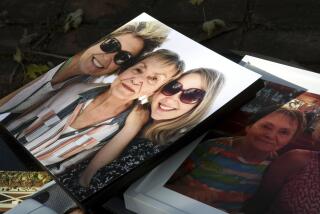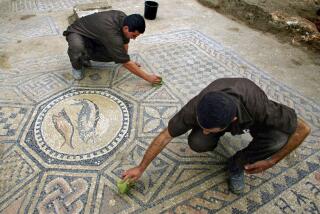Archaeology journal says burial box of Jesus’ brother is genuine
- Share via
A limestone box bearing the inscription “James, son of Joseph, brother of Jesus” in Aramaic appears to be genuine, the prestigious Biblical Archaeology Review said Wednesday in a long story written by editor Hershel Shanks. The ossuary, dating from AD 63, has been highly controversial, with Israeli authorities claiming it is a forgery and prosecuting antiquities dealer Oded Golan, who originally sold it. That trial ended in March when a judge dismissed the charges, saying that the prosecutor had not proved claims that the ossuary was a fake. Shanks has provided no new evidence of the ossuary’s authenticity, but he does refute some of the government’s key arguments in that trial.
The 20-inch-long box is slightly trapezoidal in shape, wider at the top than the bottom. The lid is slightly convex. Such boxes were used in the 1st century to hold bones after a person’s flesh had melted away in a cave. The controversial box was discovered in a private collection by paleographer Andre Lemaire of the Sorbonne University in Paris, but it has never been clear where the box was originally found. The discovery was first announced in the pages of Biblical Archaeology Review in October 2002 and, shortly thereafter, the ossuary was placed on display at the Royal Ontario Museum in Toronto in conjunction with a religious meeting.
The fact that the box was revealed through all this “hoopla” rather than through formal scientific publication is the main reason the Israeli government and many scientists doubt the authenticity of the box, Shanks said.
The government’s claim that the ossuary is a forgery was based on three key pieces of evidence. 1) Clay expert Yuval Goren of Tel Aviv University claimed that he found an artificial patina, which he called the “James Bond,” on the inscription. 2) A former employee of the Israel Antiquities Authority named Joe Zias claimed that he had previously seen the box in the shop of an antiquities dealer and that the words “brother of Jesus” were not on it. 3) An Egyptian craftsman or jeweler named Marco had claimed to have worked with Golan faking antiquities.
Marco never appeared at the trial because of difficulties in Egyptian-Israeli relations. But when Shanks visited him in his shop in Cairo’s Kahn Khalili bazaar, Marco claimed that he had never helped Golan fake any artifacts. He told the same story to an Israeli newspaper and to Israeli police who visited him in Cairo, Shanks reported. Other sources, however, say Marco admitted faking items to the Israeli police. “It’s a good thing the prosecutors did not call Marco as a witness,” Shanks wrote. “He would have hurt their case still more.”
Zias’ claim also fell apart. He said he has seen the ossuary in an antiquities store called the Fortress of Antonia owned by Mahmoud Abushakra on the Via Dolorosa. Shanks tracked down Abushakra at his retirement home in Saxony, Germany. He said that he had never possessed such an ossuary. He did have one that said “Joseph, son of Judah, son of Hadas,” but the inscription was kept facing a wall and Zias could not have seen it. Moreover, Zias admitted at the trial, he could not read Aramaic and thus would have no idea what the writing said even if he had seen it. After the trial, Zias said he had only been “joking” about seeing the ossuary and that Shanks had “no sense of humor.”
Goren said he had discovered a fake patina on the inscription, particularly the phrase “brother of Jesus.” The patina was made of crushed limestone and water, and he cleverly called it the James Bond. Other researchers, however, noted that such patinas are sometimes produced when antiquities dealers clean the artifacts for display. Evidence at the trial indicated that there was a real patina under the fake one, and Goren admitted it on the stand. He later argued that, perhaps, the forger had used scratches in the box as part of the text, explaining the presence of a genuine patina.
Ultimately, the judge dismissed the charges against Golan, but he did not rule on the authenticity of the ossuary. “The prosecution failed to prove beyond all reasonable doubt what was stated in the indictment: that the ossuary is a forgery and that Mr. Golan or someone acting on his behalf forged it,” he wrote. “This is not to say that the inscription on the ossuary is true and authentic and was written 2000 years ago...There is nothing in these findings which necessarily proves that the items were authentic.” And that probably will be the last word on the subject until, or if, other scientific evidence can be obtained.
LATimesScience@gmail.com
Twitter/@LATMaugh






